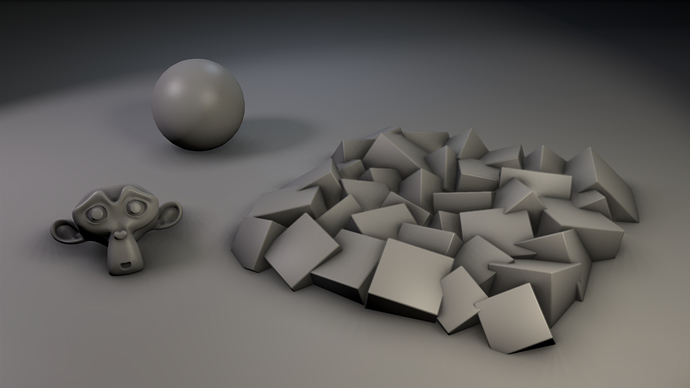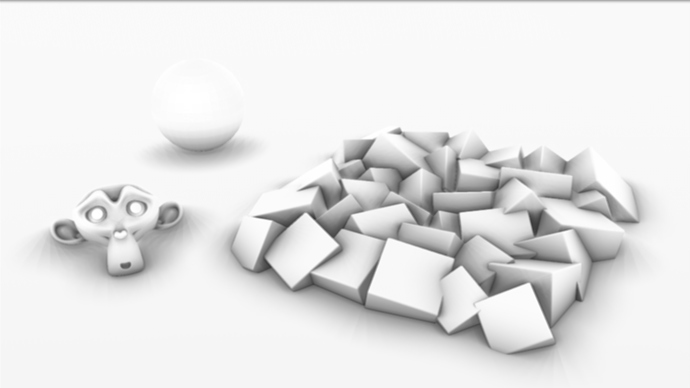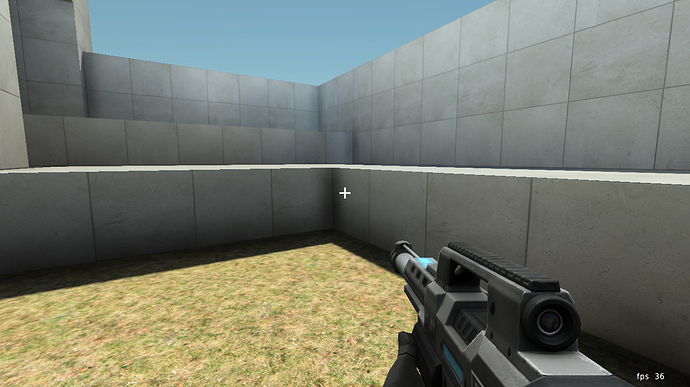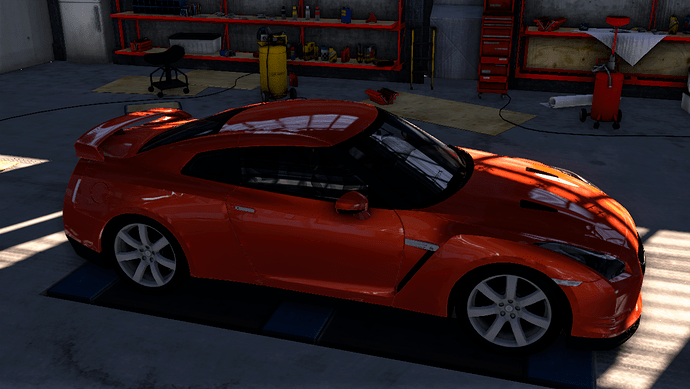Update 1: See this post
Original post:
Hi,
the following shader is an implementation of the very beautiful and up-to-date “Horizon Based Ambient Occlusion” AO method for the BGE.
Some test-scene results:
(test scene with shader)
(the pure HBAO shader pass)
(comparison of HBAO and SSAO)
To set it up, just add it as a 2D filter and change the shader’s variables to match your scene.
I would also recommend to use the UPBGE branch for the best performance (it really does make a huge difference!).
Shader download: REMOVED - use version in update post
Shader code:
uniform sampler2D bgl_DepthTexture;
uniform sampler2D bgl_RenderedTexture;
uniform float bgl_RenderedTextureWidth;
uniform float bgl_RenderedTextureHeight;
//THIS NEEDS TO MATCH YOUR CAMERA SETTINGS---------------------
const float znear = 0.1; //Z-near
const float zfar = 100.0; //Z-far
const float fov = 50.0; //FoV
//-------------------------------------------------------------
//USER VARIABLES-----------------------------------------------
const float intensity = 1.2; //Intensity of the AO effect
const float sampleRadius = 9.0; //Radius of the AO, bigger values need more performance
const float sampleDirections = 10.0; //Main sample count, affects performance heavily
const float sampleSteps = 32.0; //SubSample count, sometimes higher values are faster
const bool useAttenuation = false; //Applies attenuation to each AO sample, different values look better depending on your scene
const float attenuationScale = 1.0; //Depth scale of the attenuation, different values look better depending on your scene
const float angleBias = 0.2; //Brightens up the AO effect to reduce noise and artifacts
const bool noise = false; //Use noise instead of pattern for sample dithering, much slower but more accurate
const float noiseamount = 1.0; //Per-Pixel noise amount, bigger values need more performance
const float jitterAmount = 1.0; //Per-Sample noise amount, bigger values need more performance
const float lumInfluence = 0.3; //Influence of the luminance on the AO effect
const bool onlyAO = false; //Only show AO pass for debugging
const bool externalBlur = false; //Store AO in alpha pass for a later blur
//-------------------------------------------------------------
float width = bgl_RenderedTextureWidth;
float height = bgl_RenderedTextureHeight;
vec2 texCoord = gl_TexCoord[0].st;
float aspectratio = width/height;
float thfov = tan(fov * 0.0087266462597222);
const float TWO_PI = 6.283185307;
vec3 getLinearColor(vec2 coord)
{
vec3 C = vec3(texture2D(bgl_RenderedTexture, coord));
C.r = pow(C.r, 2.2);
C.g = pow(C.g, 2.2);
C.b = pow(C.b, 2.2);
return C.rgb;
}
vec3 sRGBToLinear(vec3 C)
{
C.r = pow(C.r, 2.2);
C.g = pow(C.g, 2.2);
C.b = pow(C.b, 2.2);
return C.rgb;
}
vec3 linearTosRGB(vec3 C)
{
C.r = pow(C.r, 0.45454545);
C.g = pow(C.g, 0.45454545);
C.b = pow(C.b, 0.45454545);
return C.rgb;
}
float getLinearDepth(vec2 coord)
{
float zdepth = texture2D(bgl_DepthTexture,coord).x;
return zfar*znear / (zfar + zdepth * (znear - zfar));
}
vec3 getViewVector(vec2 coord)
{
vec2 ndc = (coord * 2.0 - 1.0);
return vec3(ndc.x*thfov, ndc.y*thfov/aspectratio, 1.0);
}
vec3 getViewPosition(vec2 coord)
{
return getViewVector(coord) * getLinearDepth(coord);
}
vec3 getViewNormal(vec2 coord)
{
float pW = 1.0/width;
float pH = 1.0/height;
vec3 p1 = getViewPosition(coord+vec2(pW,0.0)).xyz;
vec3 p2 = getViewPosition(coord+vec2(0.0,pH)).xyz;
vec3 p3 = getViewPosition(coord+vec2(-pW,0.0)).xyz;
vec3 p4 = getViewPosition(coord+vec2(0.0,-pH)).xyz;
vec3 vP = getViewPosition(coord);
vec3 dx = vP-p1;
vec3 dy = p2-vP;
vec3 dx2 = p3-vP;
vec3 dy2 = vP-p4;
if(length(dx2)<length(dx)&&coord.x-pW>=0||coord.x+pW>1) {
dx = dx2;
}
if(length(dy2)<length(dy)&&coord.y-pH>=0||coord.y+pH>1) {
dy = dy2;
}
return normalize(cross( dx , dy ));
}
float rand(vec2 co)
{
if (noise) {
return fract(sin(dot(co.xy,vec2(12.9898,78.233)*3.0)) * 43758.5453);
} else {
return ((fract(1.0-co.s*(width/2.0))*0.3)+(fract(co.t*(height/2.0))*0.6))*2.0-1.0;
}
}
vec2 rand2D(vec2 coord) //generating noise/pattern texture for dithering
{
float noiseX = ((fract(1.0-coord.s*(width/2.0))*0.25)+(fract(coord.t*(height/2.0))*0.75))*2.0-1.0;
float noiseY = ((fract(1.0-coord.s*(width/2.0))*0.75)+(fract(coord.t*(height/2.0))*0.25))*2.0-1.0;
if (noise)
{
noiseX = clamp(fract(sin(dot(coord ,vec2(12.9898,78.233))) * 43758.5453),0.0,1.0)*2.0-1.0;
noiseY = clamp(fract(sin(dot(coord ,vec2(12.9898,78.233)*2.0)) * 43758.5453),0.0,1.0)*2.0-1.0;
}
return vec2(noiseX,noiseY)*noiseamount;
}
mat4 getViewProjectionMatrix()
{
mat4 result;
float frustumDepth = zfar - znear;
float oneOverDepth = 1 / frustumDepth;
result[0][0] = 1 / thfov;
result[1][1] = aspectratio * result[0][0];
result[2][2] = zfar * oneOverDepth;
result[2][3] = 1;
result[3][2] = (-zfar * znear) * oneOverDepth;
return result;
}
vec2 ComputeFOVProjection(vec3 pos, mat4 VPM)
{
vec4 offset = vec4(pos, 1.0);
offset = VPM * offset;
offset.xy /= offset.w;
return offset.xy * 0.5 + 0.5;
}
void main()
{
mat4 VPM = getViewProjectionMatrix();
mat4 viewProjectionInverseMatrix = inverse(VPM);
vec3 color = texture2D(bgl_RenderedTexture,texCoord).rgb;
vec3 originVS = getViewPosition(texCoord);
vec3 normalVS = getViewNormal(texCoord);
float radiusSS = 0.0;
float radiusWS = 0.0;
radiusSS = sampleRadius;
vec4 temp0 = viewProjectionInverseMatrix * vec4(0.0, 0.0, -1.0, 1.0);
vec3 out0 = temp0.xyz;
vec4 temp1 = viewProjectionInverseMatrix * vec4(radiusSS, 0.0, -1.0, 1.0);
vec3 out1 = temp1.xyz;
radiusWS = min(tan(radiusSS * fov * 0.0087266462597222) * originVS.z, length(out1 - out0));
/*if (radiusSS < 1.0 / width) {
gl_FragColor.rgb = color;
gl_FragColor.a = 1.0;
return;
}*/
const float theta = TWO_PI / float(sampleDirections);
float cosTheta = cos(theta);
float sinTheta = sin(theta);
mat2 deltaRotationMatrix = mat2(cosTheta, -sinTheta, sinTheta, cosTheta);
vec2 deltaUV = vec2(1.0, 0.0) * (radiusSS / (float(sampleDirections * sampleSteps) + 1.0));
vec2 sampleNoise = rand2D(texCoord);
mat2 rotationMatrix = mat2(sampleNoise.x, -sampleNoise.y,
sampleNoise.y, sampleNoise.x);
deltaUV = rotationMatrix * deltaUV;
float occlusion = 0.0;
float jitter = rand(texCoord) * jitterAmount;
for(int i = 0; i < sampleDirections; i++) {
deltaUV = deltaRotationMatrix * deltaUV;
vec2 sampleDirUV = deltaUV;
float oldAngle = angleBias;
for(int j = 0; j < sampleDirections; j++) {
vec2 sampleUV = texCoord + (jitter + float(j)) * sampleDirUV;
vec3 sampleVS = getViewPosition(sampleUV);
vec3 sampleDirVS = (sampleVS - originVS);
float gamma = 1.570796326 - acos(dot(normalVS, normalize(sampleDirVS)));
if (gamma > oldAngle) {
float value = sin(gamma) - sin(oldAngle);
if(useAttenuation) {
float attenuation = clamp(1.0 - pow(length(sampleDirVS) / radiusWS * attenuationScale, 2.0), 0.0, 1.0);
occlusion += attenuation * value;
} else {
occlusion += value;
}
oldAngle = gamma;
}
}
}
occlusion = 1.0 - occlusion / float(sampleDirections);
occlusion = clamp(pow(occlusion, 1.0 + intensity), 0.0, 1.0);
vec3 lumcoeff = vec3(0.299,0.587,0.114);
float lum = dot(color.rgb, lumcoeff) * lumInfluence;
occlusion = lum + ((1.0 - lum) * occlusion);
gl_FragColor.rgb = color * occlusion;
gl_FragColor.a = occlusion;
if(externalBlur) {
gl_FragColor.rgb = color;
gl_FragColor.a = occlusion;
}
if(onlyAO) {
gl_FragColor.rgb = vec3(occlusion);
gl_FragColor.a = 1.0;
}
//gl_FragColor.rgb = vec3(jitter);
}












